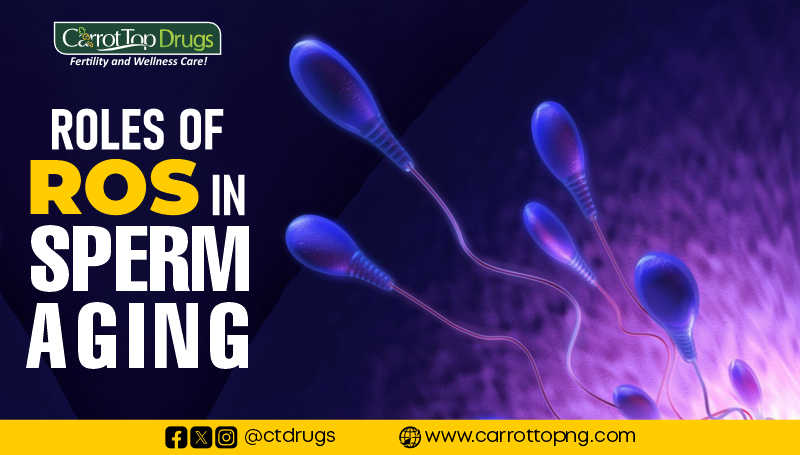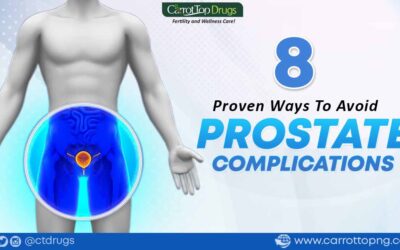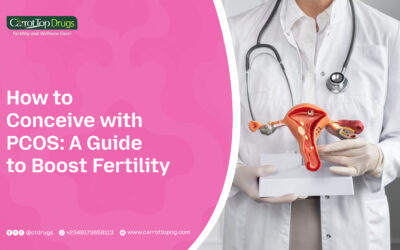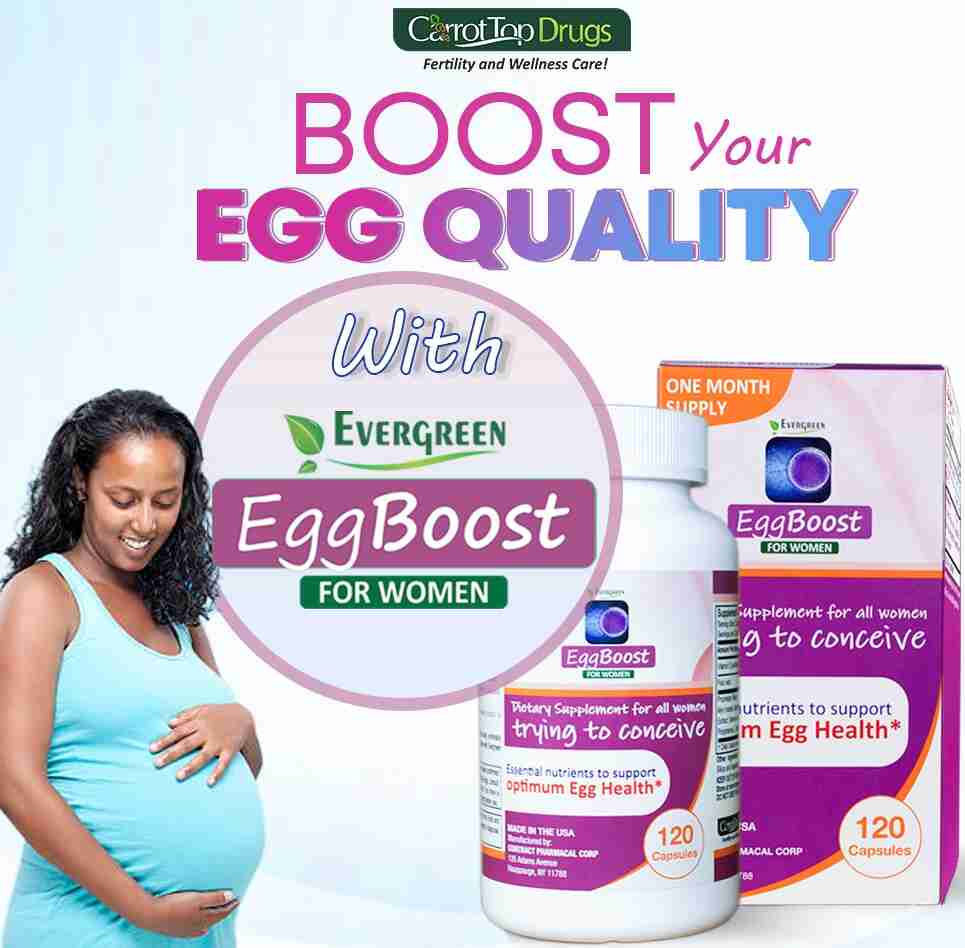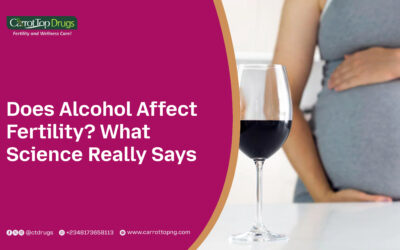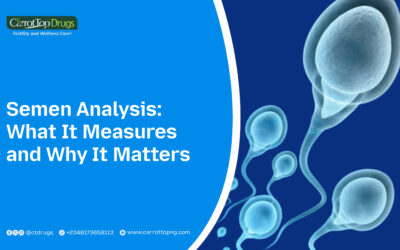Introduction
Reactive oxygen species (ROS) have emerged as significant contributors to the aging process of sperm and are closely associated with male infertility. Understanding the role of reactive oxygen species on sperm aging is critical for developing strategies to mitigate their detrimental effects and improve male reproductive health. This article reveals the nature of ROS, the statistics linking ROS to male infertility, the various roles ROS play in the aging of sperm and how to manage it for sperm health.
What is ROS?
Reactive oxygen species (ROS) are chemically reactive molecules containing oxygen. These include free radicals such as superoxide (O2•−), hydroxyl radical (•OH), and non-radical molecules like hydrogen peroxide (H2O2) and singlet oxygen (O2). ROS are natural byproducts of cellular metabolism, primarily produced in the mitochondria during the process of oxidative phosphorylation. According to Sies and Jones, Under normal physiological conditions, ROS play a vital role in cell signaling, immune response, and homeostasis.
However, excessive production of ROS or a deficiency in antioxidant defenses leads to a state known as oxidative stress. This imbalance can result in significant cellular damage, affecting lipids, proteins, and DNA. In the context of sperm, which are particularly vulnerable due to their high content of polyunsaturated fatty acids and limited cytoplasmic antioxidants, ROS-induced damage can impair motility, viability, and genetic integrity.
Statistics of Male Infertility Associated with ROS
Male infertility is a global health concern, affecting approximately 15% of couples worldwide, with male factors contributing to nearly half of these cases. Studies by N.B Takalani have shown that oxidative stress is a major contributing factor to male infertility, with elevated ROS levels detected in 30-80% of infertile men.
Sperm DNA fragmentation, a marker of oxidative stress, is significantly higher in infertile men compared to fertile controls. It has been reported that men with high levels of sperm DNA fragmentation have a two-fold increase in the risk of infertility. Moreover, oxidative stress is implicated in various sperm dysfunctions, including decreased motility, abnormal morphology, and reduced fertilization capacity, further establishing the link between ROS and male infertility.
Common Sources of ROS Exposure for Men
Reactive oxygen species (ROS) can originate from various external and internal sources. Identifying and managing these sources is crucial for maintaining optimal sperm health and overall well-being. Here are the common sources of ROS exposure for men:
1. Environmental Pollutants Air Pollution:
Exposure to pollutants like ozone, nitrogen dioxide, and particulate matter can increase oxidative stress. Industrial Emissions: Chemicals and heavy metals from factories and industries contribute to ROS generation.
2. Tobacco Smoke Cigarette Smoking:
Contains numerous toxins and free radicals that significantly increase ROS levels, affecting sperm quality and overall health.
3. Alcohol Consumption Excessive Alcohol Intake:
Metabolism of alcohol produces ROS, leading to oxidative stress and damage to sperm cells.
4. Poor Diet Processed Foods:
High in sugars and unhealthy fats, processed foods can increase oxidative stress. Lack of Antioxidants: Diets low in fruits, vegetables, and other antioxidant-rich foods fail to counteract ROS effectively.
5. Physical and Psychological Stress Chronic Stress:
Both physical and psychological stress can lead to increased ROS production. Intense Exercise: While moderate exercise is beneficial, excessive physical activity can increase ROS levels.
6. Radiation Ultraviolet (UV) Radiation:
Prolonged exposure to sunlight and tanning beds generates ROS in the skin. Ionizing Radiation: Exposure from medical imaging (e.g., X-rays) and environmental sources increases oxidative stress.
7. Occupational Hazards Chemical Exposure:
Jobs involving chemicals, solvents, and pesticides can elevate ROS levels. Heavy Metal Exposure: Occupations with exposure to heavy metals like lead and mercury contribute to oxidative stress.
8. Polluted Water Contaminated Drinking Water:
Water contaminated with heavy metals, industrial chemicals, and pesticides can lead to increased ROS.
9. Medications Certain Pharmaceuticals:
Some medications, especially when used long-term, can contribute to ROS production as a side effect.
10. Infections and Inflammation Chronic Infections:
Persistent infections can lead to prolonged inflammation and increased ROS production. Autoimmune Diseases: Conditions that cause chronic inflammation elevate ROS levels.
11. Lifestyle Factors Sedentary Lifestyle:
Lack of physical activity can contribute to oxidative stress.
12. Obesity:
Excess body fat is associated with increased ROS production.
Role of Reactive Oxygen Species in Sperm Aging
1. Oxidative Stress and Sperm Aging
A major role of ROS in sperm aging is that it induces oxidative stress. Oxidative stress is a primary factor in sperm aging. As sperm cells age, their antioxidant defenses weaken, making them more susceptible to oxidative damage. This imbalance leads to lipid peroxidation of the sperm membrane, impairing its fluidity and functionality. The loss of membrane integrity affects sperm motility and the ability to fertilize an oocyte, crucial aspects of reproductive success.
2. Damage to Sperm Components
Another role of ROS in sperm aging is the damage of sperm componenents. Reactive oxygen species cause significant damage to various sperm components:
- Lipid Peroxidation: The high content of polyunsaturated fatty acids in sperm membranes makes them highly susceptible to ROS-induced lipid peroxidation. This process results in the formation of malondialdehyde, a toxic byproduct, which compromises membrane fluidity and sperm motility.
- DNA Damage: ROS can directly damage sperm DNA, causing strand breaks and base modifications. Such damage compromises the genetic integrity of sperm and can result in decreased fertilization rates, poor embryo development, and increased risk of genetic diseases in offspring (Sharma et al., 2016).
- Protein Oxidation: Proteins in sperm, including those critical for motility and energy production, can be oxidized by ROS, leading to their dysfunction. This impacts the sperm’s overall functionality and its ability to successfully reach and fertilize the oocyte.
3. Mitochondrial Dysfunction
Mitochondria are both a major source and a target of reactive oxygen species. Another role of ROS in sperm aging is mitochondrial dysfunction. In aging sperm, mitochondrial dysfunction becomes more prevalent, leading to increased ROS production. Damaged mitochondria exacerbate the production of ROS, creating a detrimental feedback loop. This not only impacts ATP production required for sperm motility but also amplifies oxidative damage to other cellular components.
4. Antioxidant Defense Mechanisms
Sperm cells possess a range of antioxidant defense mechanisms to counteract the harmful effects of reactive oxygen species. Enzymatic antioxidants such as superoxide dismutase (SOD), catalase, and glutathione peroxidase, along with non-enzymatic antioxidants like vitamin C, vitamin E, and glutathione, play crucial roles in neutralizing ROS. However, in aged sperm, these defense mechanisms are often compromised, leading to increased susceptibility to oxidative damage and subsequent decline in sperm quality and function.
5. Impact on Fertility
The most catastrophic role of ROS in sperm aging is its effect on male fertility. Here are some of the ways it does this:
- Reduced Motility: Oxidative damage to the sperm membrane and flagellar structure reduces sperm motility, diminishing the ability to reach and fertilize the oocyte.
- Decreased Viability: Elevated ROS levels can induce apoptosis in sperm cells, leading to decreased sperm count and viability.
- Impaired DNA Integrity: ROS-induced DNA damage in sperm contributes to lower fertilization rates, poor embryo quality, and an increased risk of miscarriage or genetic abnormalities in offspring.
Managing ROS for Sperm Health
Managing reactive oxygen species (ROS) is crucial for maintaining sperm health and improving male fertility. Here are several strategies:
1. Antioxidant Supplementation
Antioxidants can neutralize ROS and mitigate oxidative stress. Common supplements include:
- Vitamin C and E: Both vitamins act as powerful antioxidants. Vitamin C protects sperm from oxidative damage, while Vitamin E stabilizes cell membranes.
- Coenzyme Q10: Improves mitochondrial function and reduces ROS production.
- Zinc and Selenium: Essential for antioxidant enzyme function and sperm DNA integrity.
Our Evergreen Formular for Men contains these antioxidants and thus helps to tackle the harmful effect of ROS in sperm aging.
2. Healthy Diet
A diet rich in antioxidants supports sperm health. Foods such as fruits, vegetables, nuts, and seeds provide essential nutrients. Consuming foods high in omega-3 fatty acids, such as fish and flaxseeds, helps reduce inflammation and ROS levels.
3. Lifestyle Modifications
Certain lifestyle changes can significantly reduce ROS production:
- Avoid Smoking and Excessive Alcohol: Both activities increase ROS production and oxidative stress.
- Maintain a Healthy Weight: Obesity is linked to increased ROS and reduced sperm quality.
- Regular Exercise: Moderate physical activity enhances antioxidant defenses, though excessive exercise may increase ROS.
4. Reduce Exposure to Environmental Toxins
Minimize exposure to pollutants, pesticides, and heavy metals, which can increase oxidative stress. Use protective gear and follow safety guidelines if exposure is unavoidable.
5. Stress Management
Chronic stress elevates ROS levels. Techniques such as meditation, yoga, and adequate sleep help manage stress and reduce oxidative stress.
6. Medical Interventions
Consult a healthcare professional for targeted treatments. Medications or assisted reproductive technologies like IVF, ICSI, IUI, etc may be necessary for underlying conditions affecting ROS balance.
7. Regular Screening
Routine semen analysis can help monitor sperm health and oxidative stress levels. Early detection of abnormalities allows for timely interventions. Some of such tests include semen analysis, sperm DNA fragmentation test, reactive oxygen species (ROS) test, total antioxidant capacity (TAC) test, lipid peroxidation assay (e.g., malondialdehyde – MDA test), etc
Conclusion
Reactive oxygen species (ROS) play a critical role in sperm aging and male infertility. Understanding their sources and impact is essential for managing oxidative stress and maintaining reproductive health. Excessive ROS can arise from various environmental pollutants, lifestyle factors, occupational hazards, and dietary deficiencies, leading to oxidative damage in sperm cells. Strategies to manage ROS levels include antioxidant supplementation, adopting a healthy diet, lifestyle modifications, reducing exposure to environmental toxins, managing stress, seeking medical interventions, and regular health screenings.
FAQs
- What are ROS and why are they harmful to sperm?
Reactive oxygen species (ROS) are chemically reactive molecules containing oxygen. While they play roles in normal cellular functions, excessive ROS cause oxidative stress, damaging sperm DNA, membranes, and proteins, which impairs fertility.
- How do antioxidants help in managing ROS for sperm health?
Antioxidants neutralize ROS, reducing oxidative stress and preventing cellular damage. Supplements like vitamins C and E, Coenzyme Q10, zinc, and selenium are particularly beneficial for sperm health.
- Can lifestyle changes improve sperm health by reducing ROS?
Yes, lifestyle changes such as quitting smoking, reducing alcohol intake, maintaining a healthy weight, eating a balanced diet, exercising moderately, and managing stress can significantly reduce ROS levels and improve sperm health.
- What dietary changes can help manage ROS for better sperm health?
A diet rich in antioxidants, including fruits, vegetables, nuts, seeds, and foods high in omega-3 fatty acids, helps reduce oxidative stress. Avoiding processed foods and sugars also benefits sperm health.
- How do environmental toxins affect ROS levels in sperm?
Environmental toxins such as pollutants, pesticides, and heavy metals increase oxidative stress by generating excess ROS. Reducing exposure to these toxins can help maintain sperm health.
- Is regular screening important for managing ROS and sperm health?
Yes, regular semen analysis can monitor sperm health and oxidative stress levels, allowing for early detection of issues and timely interventions to manage ROS.
- What medical interventions are available for managing ROS in sperm?
Medical interventions include antioxidant supplements, medications to treat underlying conditions, and assisted reproductive technologies. Consulting a healthcare professional is essential for personalized treatment.

